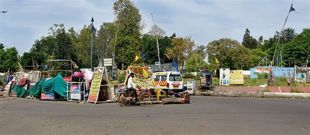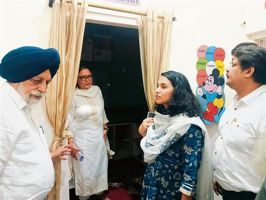Ajay Ramola
Tribune News Service
Mussoorie, November 30
Women and men of Bhatoli village pulled a rope called “Bhand” during a tug-of-war competition on the second day of the Bagwaal festival being celebrated across the Jaunpur and Jaunsar region today.
Villagers from Bhidyana and Gaonkhet arrived in a large number at Bhatoli for the celebrations. Bagwaal is celebrated in the mid-Himalayan region of Jaunpur, Rawain, Jaunsaar-Bhabar and some parts of Sirmaur district of Himachal Pradesh. It is celebrated continuously for three to five days with different significance each day.
Surat Singh, former sarpanch of Bhatoli village, said Bagwaal is celebrated a month after Diwali, as it was believed that the information of Lord Rama’s return from Lanka to Ayodhya reached late in these areas. The festivities began with lighting of fire and creating torches with the help of a local plant called Bhimal.
This tradition on the first day is called Holiath and Biruri, which is part of the festivities celebrated by preparing special dishes, namely Askya (a produce of Jhangora rice) that is distributed among villagers. Walnuts are collected door to door and brought by villagers at the common lawn of the village where women try to snatch them to get the most of the collection, thus marking the Biruri festivities.
Today, ‘bhand’ (rope-making tradition) was orgainsed in which villagers prepared a rope from locally available grass for the tug-of-war between them late at night. ‘Bhand’ has a mythological bearing and is related with the “samudra manthan”. The rope signifies the Vasuki snake that was used during the ocean churning. The rope when completed is taken to the Nagraaj temple where it is offered water and after the tug-of-war game between men and women.
According to Upendar Lekhwar, a villager from Jaunpur, a mythical Nagin, roamed villages in the Jaunpur region and was killed by mistake. The place where the Nagin was killed, a grass called ‘Babai’ emerged and is believed to be the same snake. Hence the rope is a mark of respect for the snake. Another reason is that most of the snakes are in hibernation during the winter and villagers try to pleased them not to bite them during the summer when they come out of hibernation.
Bagwaal is also celebrated to commemorate the victory of the hero of Garhwal, Madho Singh Bhandari, in a battle. He returned a month after Diwali. To celebrate Bhandari’s return, men and women take a rope to their fields and organise tug-of-wars till late night. Bouts stop only after the rope breaks, added Bachan Singh. The festivities end with ‘Mandaan’ in which the Pandava nritya is performed by villagers. The festival denotes the victory of good over evil.



























